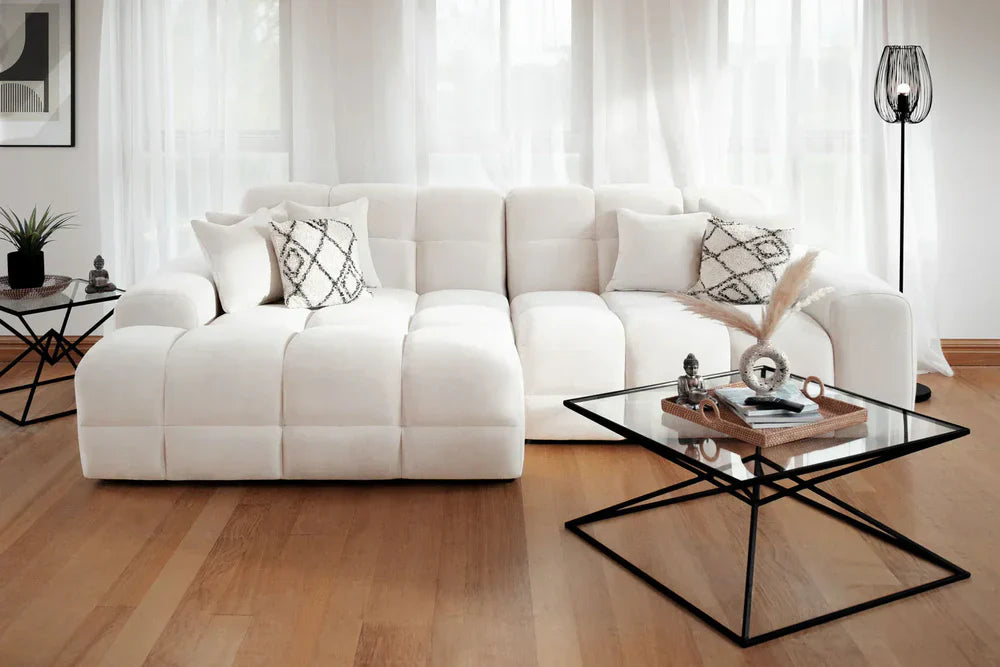Choosing a sofa for a small living room can be a challenge. You want something stylish, practical, and comfortable—but space is limited, and the wrong choice can overwhelm the room. The good news? With the right approach, you can find a sofa that fits your space without sacrificing design or functionality.
In this blog, we’ll walk you through the key factors to consider when choosing a sofa for a small living room, so you can make the most of every square inch.
Measure Your Space Carefully
Before browsing styles or colours, the most important step is to measure your living room accurately. A sofa that looks perfect online could easily dominate your space if you haven’t factored in clearances or layout.
- Measure the full dimensions of the room, including width, length, and ceiling height
- Take note of doorways, radiators, windows, and alcoves that may affect placement
- Leave at least 30–40cm of walking space around the sofa for easy movement
- Don’t forget to check access routes—your sofa has to fit through doors, halls, or stairs
Choose the Right Sofa Size
In small living rooms, size matters. Oversized furniture can make the room feel cramped, while a carefully chosen sofa will maximise comfort without crowding the space. The goal is to find a balance between usable seating and physical footprint.
- 2 seater sofas are ideal for small flats, open-plan spaces, or minimalist setups
- Compact 3 seaters can still work if they have slim arms and a lower profile
- Avoid bulky armrests or thick back cushions that eat into seating space
- Consider modular or sectional sofas that let you adapt the shape to your room
Opt for Slim, Low-Profile Designs
Chunky furniture often dominates a small room visually—even if it fits physically. Sleek, low-profile designs help create a more open, airy feel and leave the room feeling spacious, even with a generous seating area.
- Choose sofas with narrow arms and clean lines to reduce visual bulk
- Go for a low back to keep sightlines open and make the room feel taller
- Raised legs can add a sense of openness by exposing more floor area
- Avoid heavily padded or oversized styles that dominate the room
Think About Functionality
In a small living room, your sofa often needs to do more than just provide a place to sit. Smart, multi-functional furniture can help you save space and increase the room’s practicality without adding clutter.
- Sofabeds are ideal if your living room doubles as a guest space
- Storage sofas help hide blankets, cushions, or clutter out of sight
- Recliners can offer extra comfort without taking up extra room
- Footstools with built-in storage or tray tops add convenience and versatility
Choose the Right Shape for the Layout
The shape of your sofa should complement your room’s layout. In small spaces, the wrong shape can disrupt flow and block key areas. Consider how traffic moves through the room and where your focal points are.
- L-shaped or corner sofas can work well in tight spaces by hugging walls
- Straight 2 or 3 seaters are ideal for narrow rooms or opposite media units
- Armless sofas or love seats create more visual space and flexibility
- Avoid curved designs or oversized chaises that eat into central floor space
Go Neutral, Light, or Textured
Colour plays a big role in how large or small a space feels. While you don’t have to stick with beige, lighter tones tend to reflect light better and make rooms feel more open. Textured fabrics can add warmth without making things feel heavy.
- Neutral shades like grey, cream, or taupe work well in small rooms
- Pastel colours offer subtle contrast without overwhelming the space
- Soft textures like chenille or woven fabrics create comfort without bulk
- Avoid dark, solid colours unless balanced with lighter walls and flooring
Consider Leg Style and Visibility
It may seem like a small detail, but your sofa’s leg style can affect how large or cramped the room feels. Exposed legs help make a room appear more open, while sofas that sit flat on the ground can feel heavier and more enclosed.
- Raised legs allow light to flow underneath, creating the illusion of space
- Wooden or metal legs can add contrast and style without adding weight
- Sofas without skirts or low-to-floor frames tend to look bulkier
- Choose leg colours that complement your flooring to create visual flow
Don’t Overcrowd the Room
Your sofa isn’t the only thing going in your living room. Make sure you leave space for other essentials like side tables, storage units, and your TV stand. A great sofa should work with the room, not against it.
- Use a sofa with a slim profile to free up space for other furniture
- Choose multifunctional pieces like ottomans or nesting tables
- Leave enough room for natural movement through the space
- Avoid filling every wall—leaving some blank space can help the room breathe
Look for Removable Covers and Easy-Clean Fabrics
Smaller rooms often mean closer contact with your furniture. Whether it’s kids, pets, or everyday spills, having a sofa that’s easy to keep clean will make your life easier and extend the life of your furniture.
- Removable cushion covers allow for quick washing and deep cleaning
- Faux leather or treated polyester blends are resistant to spills and marks
- Avoid high-maintenance fabrics like velvet in high-traffic areas
- Look for sofas with stain-resistant coatings or durable weaves
Use Accessories to Add Personality
Just because your sofa needs to be small doesn’t mean it has to be boring. Cushions, throws, and rugs help you add character, colour, and texture—without taking up extra space. They also give you the flexibility to change the look over time.
- Use cushions to introduce bold colours or seasonal themes
- A lightweight throw can soften the shape of a smaller sofa
- Place a compact rug underneath to define the seating area
- Add wall art or floating shelves to bring style upwards without clutter
Modular and Custom Options for Tight Spaces
If your room has an awkward layout or you’re working with unusual dimensions, modular sofas offer the flexibility to build a configuration that works. These can often be added to or rearranged later if your needs change.
- Modular sofas allow you to choose only the sections that fit your space
- Chaise sections or footstools can be moved depending on layout
- Some designs come with interchangeable arms or backs
- Modular pieces can be delivered in parts—ideal for homes with tight access
Plan Your Layout First
Before you fall in love with a specific sofa, take time to plan your living room layout. Knowing where everything will go helps you choose a sofa that fits, both visually and practically.
- Sketch out the room and experiment with different furniture positions
- Factor in windows, doors, radiators, and sightlines to your TV
- Use painter’s tape on the floor to mark out sofa dimensions
- Consider how you’ll use the room day-to-day before deciding
Final Thoughts
Choosing the right sofa for a small living room isn’t just about squeezing in a seat—it’s about enhancing the space, maximising comfort, and creating a home that feels both stylish and functional. With a smart approach to size, shape, fabric, and layout, even the smallest room can feel open, inviting, and complete.
At Ready2Go Furniture, we stock a wide range of space-saving sofas, including compact 2 seaters, modular options, armchairs, sofabeds, and corner units—all designed for everyday living in real homes. With fast delivery, clear product details, and styles to suit every taste, we make it easy to furnish your small space without compromise.
Browse our small-space-friendly sofa collection today and make the most of every inch.

